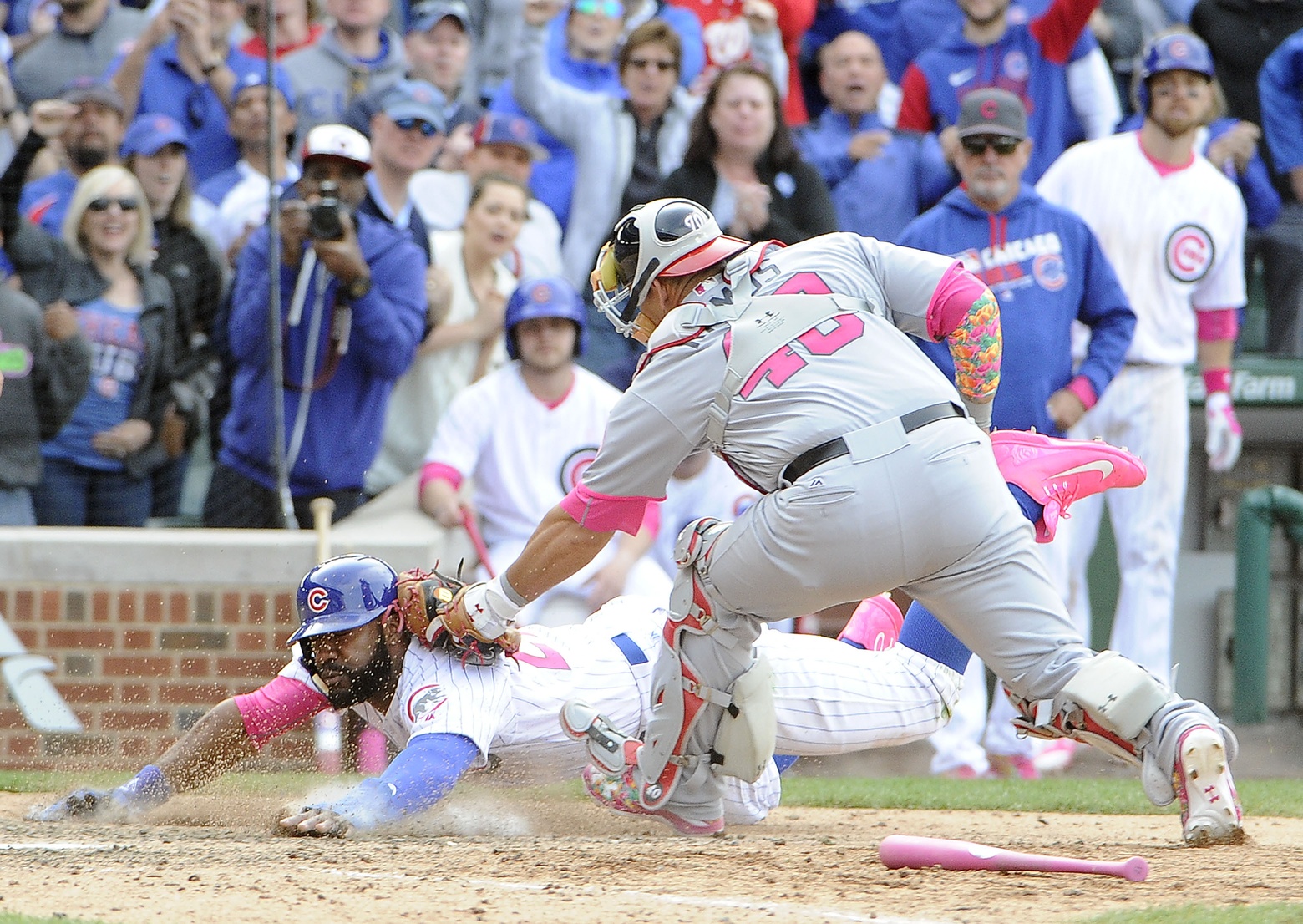Late in Sunday’s 13-inning affair, overshadowed by Javy Baez’s walk-off fireworks, the Nationals’ defense succeeded in throwing out Jason Heyward at home plate. Michael Taylor corralled the ball perfectly on one hop in right-center field and fired a throw to the cutoff man; the cutoff man, Danny Espinosa, flung the ball to catcher Wilson Ramos, chest high; and Ramos stepped to the baseline and applied the tag on Heyward as the Cubs’ outfielder dove headfirst.
Except for those Cubs fans with particularly dour outlooks (we know you exist), it was a memory quickly erased, as the club completed a sweep of the Nationals for their seventh-consecutive victory. And normally, this play wouldn’t be particularly notable, aside from it being a good defensive play by Washington. But given the dual contexts of the game—a tie game in extra innings, with the heart of the order up—and of the Cubs’ season, which so far has yielded a league-best 25-8 record, third base coach Gary Jones’s aggressive send of Heyward deserves some examination.
The Cubs lead the majors with 4.9 team Baserunning Runs this season. Yes, add it to the litany of stats in which the Cubs lead or nearly lead the league, I won’t begrudge you for tallying them. For those of you who might not be familiar, as Baserunning Runs (and baserunning quantification writ large) are fairly new, there are five components that factor into BRR: ground advancement runs, stolen base runs, air advancement runs, hit advancement runs, and “other” advancement runs. The Cubs are the only club as of this writing to be positive in all five of those categories, emblematic of a well-rounded and intelligent baserunning team.
Their baserunning prowess is frequently overshadowed by their herculean lineup and their stoic rotation, but it is a key to their dominance thus far. The Cubs take extra bases often, putting pressure on fielders to make accurate throws to the right bases, and also extend innings by sometimes taking away double plays. The last thing opposing pitchers want is to have to face more of the Cubs’ lineup, so having to face an extra batter in an inning has an outsized impact for a team like the Cubs.
For a recent “real life,” microcosmic example of the Cubs’ shining baserunning, let’s go back to Tuesday’s game versus the Padres. In the third inning, the Cubs broke the game open. Dexter Fowler and Heyward singled to lead off the inning, bringing Kris Bryant to the plate for the second time opposite rookie starter Cesar Vargas. Bryant laced a line drive over the third baseman’s head, just kissing the angled wall beyond the bullpens, bringing Fowler around to score easily from second. Melvin Upton, Jr. made a barehanded play on the ball and rocketed it back to the infield, but Heyward’s long strides carried him around third and all the way home, impressively scoring from first on ball hit very hard and fielded promptly. It’s the sort of thing that shows up in Heyward and the Cubs’ BRR, as going first to home on a double is weighed in the hit advancement opportunities factor. Heyward’s run brought the score to 3-0 Cubs.
Anthony Rizzo then grounded out to the pitcher, but Bryant was able to advance to third on the play. Even small plays like this are incorporated into BRR—taking a base on a groundout shows up in ground advancement runs. Ben Zobrist, the hottest hitter in the Cubs’ lineup, strode to the plate with a runner on third and only one out, predictably scoring Bryant on a single to right.
Sunday’s hero, Baez, kept the inning going with a liner to left. Zobrist hustled into third, drawing an unadvised throw from Upton in left; meanwhile, exhibiting that baseball IQ for which he has gained notoriety, Baez took second on the throw. Not only did it put another runner in scoring position, but Baez’s smart play also staved off a double play opportunity for one more hitter, with the bottom of the order coming up. Vargas intentionally walked Addison Russell, loading the bases, but David Ross completed the inning’s scoring with a sacrifice fly to deep right field. Those extra runs became necessary as the game wore on, as the Padres scored a few runs against the Cubs’ bullpen and made it close.
On Sunday, when Gary Jones waved Heyward around third with the game tied in the 11th, he did so with the knowledge of Heyward’s speed and skill on the basepaths. With the middle of the order up, it was still a questionable call; Anthony Rizzo was due up next, and he would have hit with one out and runners on second and third. But the fact that the play was so close, and that a nearly perfect play was necessary to get him at home, is indicative of the Cubs’ catalytic baserunning. The Cubs might not finish the season atop the baserunning leaderboards, but they’ll continue to supplement their prolific hitting by taking extra bases and forcing the defense to execute plays well.
Lead photo courtesy David Banks—USA Today Sports.

“Those extra runs became necessary as the game wore on, as the Padres scored a few runs against the Cubs’ bullpen and made it close”
I don’t agree. Read:
http://www.fangraphs.com/blogs/on-the-inequity-of-the-2015-nl-wild-card-game/
Jerrica